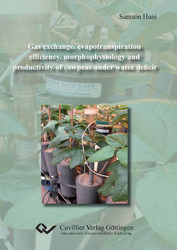| Fachbereiche | |
|---|---|
| Buchreihen (96) |
1378
|
| Nachhaltigkeit |
3
|
| Gesundheitswesen |
1
|
| Geisteswissenschaften |
2365
|
| Naturwissenschaften |
5406
|
| Mathematik | 229 |
| Informatik | 319 |
| Physik | 980 |
| Chemie | 1363 |
| Geowissenschaften | 131 |
| Humanmedizin | 243 |
| Zahn-, Mund- und Kieferheilkunde | 10 |
| Veterinärmedizin | 108 |
| Pharmazie | 147 |
| Biologie | 835 |
| Biochemie, Molekularbiologie, Gentechnologie | 121 |
| Biophysik | 25 |
| Ernährungs- und Haushaltswissenschaften | 45 |
| Land- und Agrarwissenschaften | 1004 |
| Forstwissenschaften | 201 |
| Gartenbauwissenschaft | 20 |
| Umweltforschung, Ökologie und Landespflege | 148 |
| Ingenieurwissenschaften |
1793
|
| Allgemein |
98
|
|
Leitlinien Unfallchirurgie
5. Auflage bestellen |
|
Erweiterte Suche
Gas exchange, evapotranspiration efficiency, morphophysiology and productivity of cowpeas under water deficit
Samson Huni (Autor)Vorschau
Inhaltsverzeichnis, Datei (34 KB)
Leseprobe, Datei (70 KB)
The cowpea [Vigna unguiculata (L.) Walp.], a legume which originated in Africa, is now grown in the Tropics and many subtropical regions. Cowpea is of significance for food and feed and its yield is frequently severely affected by drought, resulting in its low average yield. Hence the influence of water deficit on gas exchange, growth, development and yield of cowpea was studied here, with the aim of contributing to our understanding of the response of cowpeas to water deficit and to the provision of efficient and viable information for breeding of drought resistant genotypes. To achieve this aim, several traits were examined, which included
- gas exchange [stomatal conductance (gs), net photosynthetic rate PN), transpiration rate (E) and intrinsic transpiration efficiency TEi)], evapotranspiration efficiency (ETE), water
use (WU) and yield/yield components,
- relationship among these traits and variability among the various genotypes.
From the results it was expected that it would be possible to find efficient plant types and characteristics to predict ETE and yield which could eventually be used in cowpea drought resistance breeding programmes.
For this purpose three pot experiments were conducted in the greenhouse under drip irrigation. The control (well-watered treatment) was irrigated continuously from the beginning to the end of the experiments, while the water-deficit treatment experienced a reduced irrigation resulting in a soil water potential of -350 to -450hPa at the onset of flowering for 14 to 21 days. Measurement and analyses of various traits were carried out before the induction of water-deficit stress, during and at the end of stress. All remaining plants were then fully irrigated up to the end of the experiments. In experiments 1 and 2 the plants were harvested at maturity to determine yield and yield components, and biomass and ETE.
Water-deficit stress impacted on all analysed traits and there were variations among genotypes in both treatments. Water deficit elicited the reduction of leaf relative water content and stomatal conductance. Consequently, PN and E declined as well. However, E decreased more than PN due to the influence of stress, generally leading to a higher TEi of the water-deficit treatment. There were differences among experiments, probably due to interactions between the genotypes and the environment. After stress, gas exchange recovered to similar levels of the control treatment. Biomass production, water use and evapotranspiration efficiency varied among genotypes within and between treatments. Compared with the control, water use and growth rate decreased clearly under stress. The role of PN for biomass production became evident in the positive correlation between both parameters. TEi had no distinct relationship to ETE.
Three traits, specifically leaf temperature (ΔT), leaf senescence (expressed as leaf shedding score, LSS) and cell membrane stability (CMS, calculated from electrolyte leakage values) distinguish themselves as valuable tools for drought resistance analysis. ΔT rose up to 3°C higher under stress than well-watered conditions. LSS increased under stress as well, whereby the genotypes which shed a relative high number of leaves under well-watered conditions also shed an even higher amount of leaves under stress. The sole genotype which retained all its leaves under stress, UCR 328, maintained all its leaves green, which was probably tremendously valuable for a quick recovery of different plant processes after stress. ΔT was consistently positively correlated with LSS, but negatively with CMS, particularly under stress. ΔT and LSS also displayed significant relationships with ETE, TEi, grain yield and harvest index (HI). Owing to the fact that ΔT and LSS are simple, fast, cheap and non-invasively determined, they could be used in drought resistance breeding programmes as indirect selection traits for efficient plant types regarding transpiration, TEi, ETE and yield.
The various genotypes yielded differently and the HI also varied under both treatments, a probable indication of differing genotypic yield potential. Water deficit at flowering reduced yield, but some genotypes had a higher HI. Generally, the genotypes with a high “yield potential” also manifested a higher yield under stress. TVu 12348 had the highest yield stability, but a low yield potential. UCR 328 and IFH 27-8 had a relatively high yield stability coupled with a high yield under stress.
| ISBN-13 (Printausgabe) | 3869555998 |
| ISBN-13 (Printausgabe) | 9783869555997 |
| ISBN-13 (E-Book) | 9783736935990 |
| Sprache | Englisch |
| Seitenanzahl | 136 |
| Auflage | 1 Aufl. |
| Band | 0 |
| Erscheinungsort | Göttingen |
| Promotionsort | Humboldt-Universität Berlin |
| Erscheinungsdatum | 23.12.2010 |
| Allgemeine Einordnung | Dissertation |
| Fachbereiche |
Land- und Agrarwissenschaften
|








